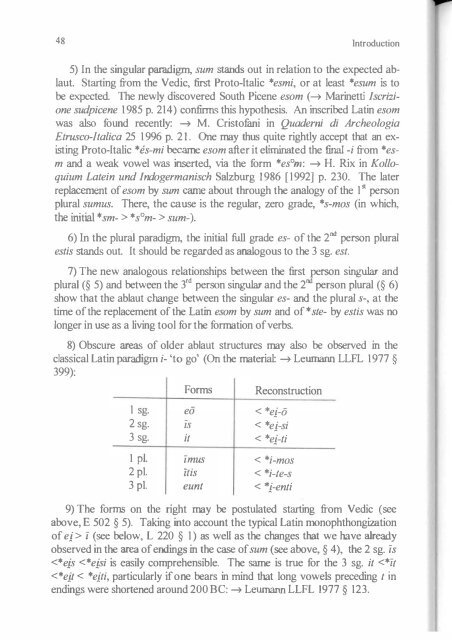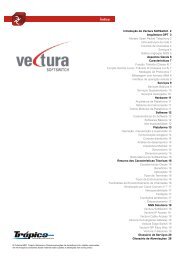You also want an ePaper? Increase the reach of your titles
YUMPU automatically turns print PDFs into web optimized ePapers that Google loves.
48 lntroduction5) In the singular paradigm, sum stands out in relation to the expected ablaut.Starting from the Vedic, first Proto-ltalic 'esmi, or at least 'esum is tobe expected. The newly discovered South Picene esom ( Marinetti lscrizionesudpicene 1985 p. 214) confirms this hypothesis. An inscribed Latin esomwas also found recently: M. Crist<strong>of</strong>uni in Quademi di ArcheologiaEtrusco-Ilalica 25 1996 p. 21. One may thus quite rightly accept that an existingProto-ltalic 'lis-mi became esom after it eliminated the finaI -i from 'esmand a weak vowel was inserted, via the form 'es"m: H. Rix in KolloquiumLalein und lndogermanisch Salzburg 1986 [I992) p. 230. The laterreplacement <strong>of</strong> esom by sum came about through the analogy <strong>of</strong> the I" pe=nplural sumus. There, the cause is the regular, zero grade, 's-mos (in which,the initial ' sm- > 'som- > sum-).6) In the plural paradigm, the initial full grade es- <strong>of</strong> the 2"" pe=n pluraleslis stands out. It should be regarded as analogous to the 3 sg. esl.7) The new analogous relationships between the first J"' =n singular andplural (§ 5) and between the 3'" person singular and the 2 person plural (§ 6)show that the ablaut change between the singular es- and the plural SO, at thetime <strong>of</strong> the replacement <strong>of</strong> the Latin esom by sum and <strong>of</strong>' sle- by eslis was nolonger in use as a living tool for the formation <strong>of</strong> verbs.8) Obscure areas <strong>of</strong> older ablaut structures may also be observed in theclassical Latin paradigm i- 'to go' (On the material: Leumann LLFL 1977 §399):FormsReconstructionI sg. eo < ·ej-a2sg. is < 'ei-si3 sg. il < *ej-liI pI. imus < *i-mos2 pI. ,lis < *i-/e-s3 pI. eunl < *j-enti9) The forms on the right may be postulated starting from Vedic (seeabove, E 502 § 5). Taking into account the typical Latin monophthongization<strong>of</strong> ei > , (see below, L 220 § I) as well as the changes that we have alreadyobserved in the area <strong>of</strong> endings in the case <strong>of</strong> sum (see above, § 4), the 2 sg. is





